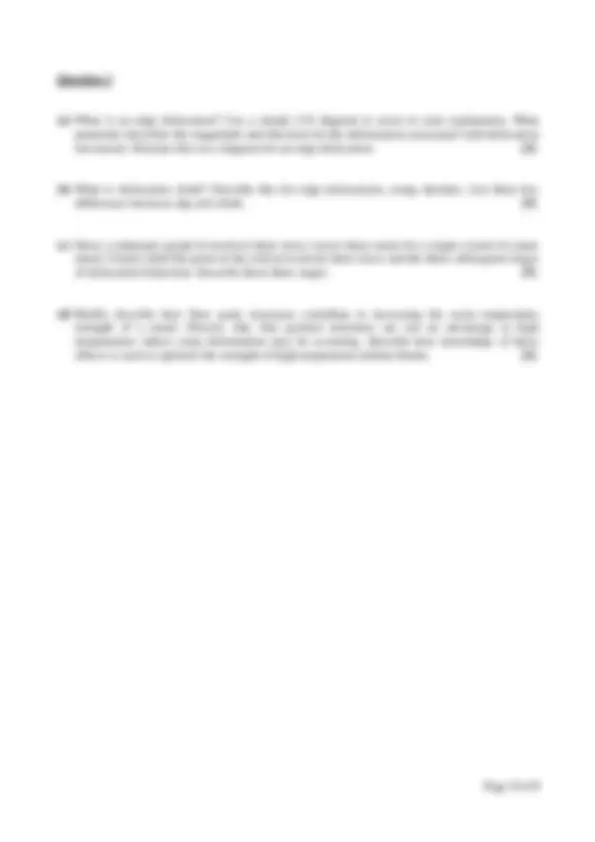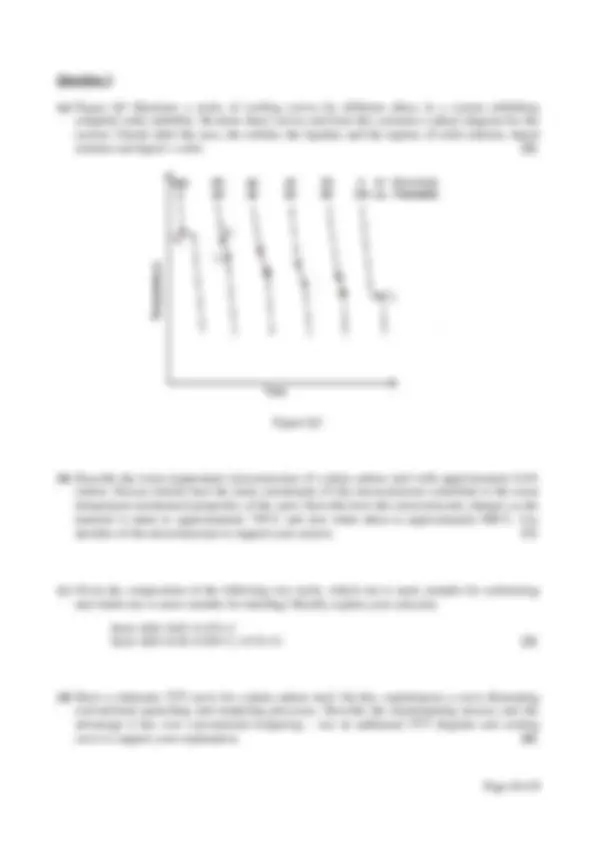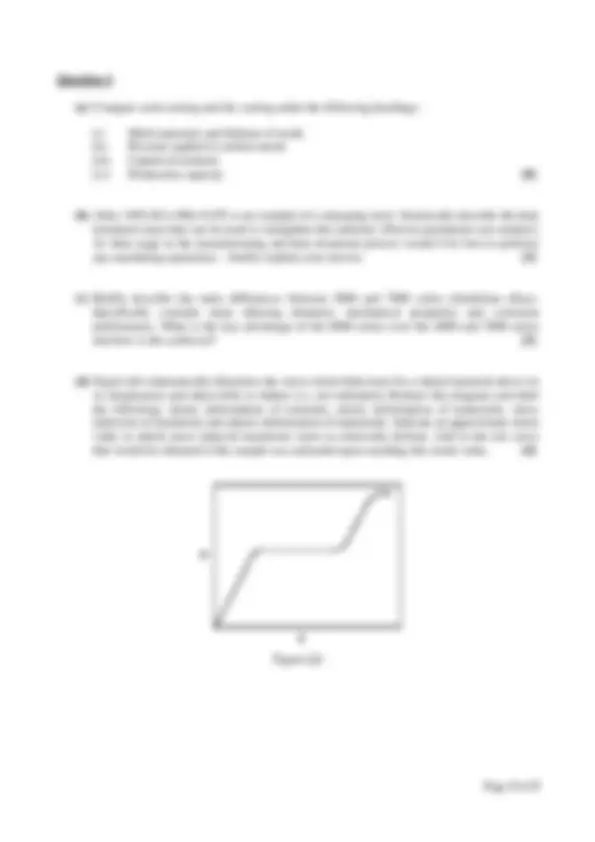





Study with the several resources on Docsity

Earn points by helping other students or get them with a premium plan


Prepare for your exams
Study with the several resources on Docsity

Earn points to download
Earn points by helping other students or get them with a premium plan
Community
Ask the community for help and clear up your study doubts
Discover the best universities in your country according to Docsity users
Free resources
Download our free guides on studying techniques, anxiety management strategies, and thesis advice from Docsity tutors
Main points of this past exam paper are: Steel Bar, Cross Sectional Area, Aluminium, Length, Deflection, Modulus, Elastic, Material, Exhibits, Engineering Stress-Strain Curve
Typology: Exams
1 / 5

This page cannot be seen from the preview
Don't miss anything!




Exam Code(s) 3BM, 3BG, 3BSE Exam(s) 3 rd^ Mechanical Engineering 3 rd^ Biomedical Engineering 3 rd^ Energy Systems Engineering
Module Code(s) ME Module(s) Metals and Metal Processing
Paper No. 1 Repeat Paper
External Examiner(s) Prof. Robin Clarke Internal Examiner(s) Prof. Sean Leen Dr. Mark Bruzzi Dr. Barry O’Brien*
Instructions: (^) This paper contains 4 questions
Answer 3 questions All questions carry equal marks
No. of Pages 5 Department(s) Mechanical & Biomedical Engineering Course Co-ordinator(s) Dr. Barry O’Brien
Requirements:
Graph Paper Yes (standard)
Release to Library: Yes
(a) A 20,000N load is applied to a steel bar with a cross sectional area of 6 cm^2. If a second bar of the same length was made of aluminium, what cross sectional area would be required to achieve the same deflection? Take the elastic modulus for steel to be 210 GPa and the elastic modulus for aluminium to be 70 GPa. [4]
(b) Draw a schematic engineering stress-strain curve for a material that initially exhibits linear elastic behaviour and subsequently exhibits work-hardening and necking down during plastic deformation. Clearly indicate the regions on the curve where behaviour is elastic, where work hardening is occurring and where necking is occurring. Indicate the yield point, ultimate tensile strength and breaking point. [4]
(c) The bond energies for iron and tungsten are 4.2 eV/atom and 8.8 eV/atom respectively. Based on this information which of the two metals has the higher elastic modulus? Briefly explain why. [3]
(d) Briefly describe the difference between covalent bonding and metallic bonding. Use simple sketches to support your description. How does the difference in bonding influence thermal and electrical conductivity? [4]
(e) Define the atomic packing factor (APF) for the unit cell of a crystal structure. The APF for Body Centred Cubic structures is 0.68 and for Face Centred Cubic structures is 0.74; what is the practical significance of this difference in APF? [3]
(f) Using a sketch of a simple (2-D) crystal lattice illustrate the following point defects: substitutional impurity, interstitial impurity, self-interstitial and a vacancy. [2]
(a) Figure Q3 illustrates a series of cooling curves for different alloys in a system exhibiting complete solid solubility. Re-draw these curves and from this construct a phase diagram for the system. Clearly label the axes, the solidus, the liquidus and the regions of solid solution, liquid solution and liquid + solid. [5]
Figure Q
(b) Describe the room temperature microstructure of a plain carbon steel with approximately 0.4% carbon. Discuss briefly how the main constituents of this microstructure contribute to the room temperature mechanical properties of the steel. Describe how this microstructure changes as the material is taken to approximately 750°C and also when taken to approximately 900°C. Use sketches of the microstructure to support your answer. [7]
(c) Given the composition of the following two steels, which one is more suitable for carburizing and which one is more suitable for nitriding? Briefly explain your selection.
Steel AISI 1025: 0.25% C Steel AISI 4120: 0.20% C, 0.5% Cr [2]
(d) Draw a schematic TTT curve for a plain carbon steel. On this, superimpose a curve illustrating conventional quenching and tempering processes. Describe the martempering process and the advantage it has over conventional tempering – use an additional TTT diagram and cooling curve to support your explanation. [6]
(a) Compare sand casting and die casting under the following headings:
(i) Mold materials and lifetime of mold. (ii) Pressure applied to molten metal. (iii) Capital investment (iv) Production capacity [8]
(b) Alloy 18Ni-8Co-4Mo-0.4Ti is an example of a maraging steel. Generically describe the heat treatment steps that can be used to strengthen this material. (Precise parameters not needed.) At what stage in the manufacturing and heat treatment process would it be best to perform any machining operations – briefly explain your answer. [3]
(c) Briefly describe the main differences between 2000 and 7000 series aluminium alloys. Specifically consider main alloying elements, mechanical properties and corrosion performance. What is the key advantage of the 8000 series over the 2000 and 7000 series and how is this achieved? [5]
(d) Figure Q4 schematically illustrates the stress-strain behaviour for a nitinol material above its Af temperature and taken fully to failure (i.e. not unloaded). Redraw this diagram and label the following: elastic deformation of austenite, elastic deformation of martensite, stress induction of martensite and plastic deformation of martensite. Indicate an approximate strain value at which stress induced martensite starts to elastically deform. Add in the test curve that would be obtained if the sample was unloaded upon reaching this strain value. [4]
Figure Q